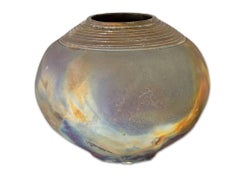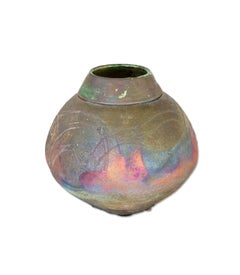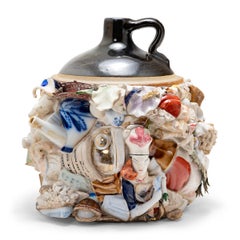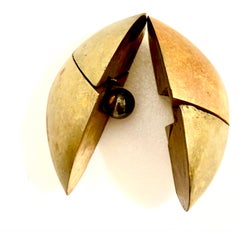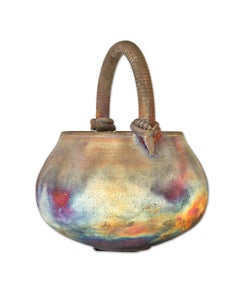Marty Marcus Art
to
2
Overall Height
to
2
2
1
1
1
1
2
2
10,138
2,779
1,375
1,369
2
Artist: Marty Marcus
"Raku Vase with Concentric Rings, " Ceramic signed by Marty Marcus
By Marty Marcus
Located in Milwaukee, WI
"Raku Vase with Concentric Rings" is a ceramic piece signed on the bottom by the artist Marty Marcus. The vase has a variety of gorgeous color variations.
7 1/4" height; 8 1/2" dia...
Category
1980s Marty Marcus Art
Materials
Ceramic
"Raku Vase with Fireworks, " colorful unique vase design lovers
By Marty Marcus
Located in Milwaukee, WI
"Raku Vase with Fireworks" is an original ceramic vase by Marty Marcus. The artist signed the piece on the bottom. It features brightly colored abstract patterns on an earth-toned background. The vessel is a unique piece of décor priced well under $900. Part of the Design Lovers Sale...
Category
1980s Post-Modern Marty Marcus Art
Materials
Ceramic
Related Items
"Beach-Combed Mochaware, " Mixed Media Sculpture
By Michael Thompson
Located in Chicago, IL
Based in Chicago, IL, contemporary artist Michael Thompson creates unique kites, collages and mixed media works assembled from material fragments of past and present collected in his travels. In his ongoing series of memory jugs, Thompson adorns stoneware vessels with a kaleidoscope of ceramic shards, found objects, and pocket-sized trinkets he collected over the course of his life.
Also known as forget-me-not jugs or spirit jars, memory jugs are African American folk art objects that honor a loved one who has recently passed. Small tokens and mementos of the deceased are gathered and affixed to the exterior of a jug or vase, an abundance of memories that celebrates a life lived to the fullest.
Michael Thompson applies this tradition to his own practice, creating tactile assemblages of this and that. Formed in the manner of collage, each jug honors the lost memories of generations past and his own memories of personally discovering each item. With varied sources for materials including Kyoto, Turkey, and Mexico, a great number of the found shards are 18th and 19th century ceramics...
Category
21st Century and Contemporary Abstract Marty Marcus Art
Materials
Stone
$5,280
H 9.75 in W 11 in D 9.5 in
Spanish Catalan Xavier Corbero Bronze Steel Architectural Abstract Sculpture
By Xavier Corberó i Olivella
Located in Surfside, FL
Xavier Corberó Olivella (1935 – 2017)
Estructuras Continual
Bronze sculpture. Comprised of four elements, independant, 1 spheric.
5 X 8 X 7 inches approximately. The pieces are kinetic and moveable so dimensions are a bit variable.
This is accompanied by a hand signed and dated photo certificate of the piece. A silver gelatin photograph. The photo is badly torn.
Xavier Corberó i Olivella (1935 – 2017) was a prominent Catalan artist, best known for monumental public sculpture and his palatial house complex in Esplugues de Llobregat near Barcelona. He has been described as "widely considered the most important Catalan artist since Antonio Gaudí," as "one of Spain’s most celebrated sculptors" and as having "perhaps influenced Barcelona more than any artist since Gaudí." Corberó's grandfather Pere Corberó i Casals (1875-1959) was an entrepreneur and artist whose works included the bronze memorial on the birthplace of Enrique Granados, also in Lleida. He was a cofounder of Barcelona's association for the promotion of decorative arts, a precursor to the Design Museum, now known as the Foment de les Arts i el Disseny. The Corberó foundry produced sculptures by prominent Catalan sculptors of the time such as Pablo Gargallo, Josep Viladomat and Frederic Marès. It was also an industrial and commercial business that sold bronze doors, chandeliers, fountains, and other decorative items, with a showroom in downtown Barcelona at Rambla de Catalunya 105, in a building designed by Arnau Calvet i Peyronill, and a workshop nearby at Carrer Aribau 103.
Pere's son and Corberó's father, Xavier Corberó i Trepat (1901-1981), also worked in the family bronze...
Category
1960s Post-Modern Marty Marcus Art
Materials
Bronze, Steel
Hundertwasser's St. Barbara Church Ceramic Miniature Including Certificate
By Friedensreich Hundertwasser
Located in Palm Desert, CA
St. Barbara Church Baernbach by Friedensreich Hundertwasser
Ceramic miniature in the scale 1:140
size 12 x 9 x 12 cm
Each ceramic object is individually handmade, hand-painted and b...
Category
Early 2000s Post-Modern Marty Marcus Art
Materials
Porcelain
$400
H 4.73 in W 3.55 in D 4.73 in
“Untitled”
Located in Southampton, NY
Original nickel plated over brass metal abstract sculpture by Oded Halahmy. Untitled. Signed and dated 1976. Condition is excellent. The sculpture is mounted on a thick mahogany bas...
Category
1970s Post-Modern Marty Marcus Art
Materials
Metal
Pichet Têtes, Pablo Picasso, 1950's, Sculpture, Ceramic, Pitcher, Design
By Pablo Picasso
Located in Geneva, CH
Pichet Têtes, Pablo Picasso, 1950's, Sculpture, Ceramic, Pitcher, Design
Pichet têtes
Ed. 500 pcs
1956
White earthenware clay, oxidized paraffin decorati...
Category
1950s Post-Modern Marty Marcus Art
Materials
Ceramic, Clay
$20,837
H 5.52 in W 3.55 in
Mini-monde, père et fils
Located in LE HAVRE, FR
Ceramics and resin figurines.
Unique piece
Height: 9,5 cm, 3,54 in
Length: 10 cm, 3,94 in
Signed on the base.
Work sold with invoice and certificate o...
Category
2010s Modern Marty Marcus Art
Materials
Ceramic, Synthetic Resin
1980 Italy Late 20th Century Bronze Female Nude Bust Multiple
Located in Brescia, IT
This engaging bronze sculpture on black wooden base, well represents a human bust, but for its expressive force, the bust turns into an abstract shape of it.
The artist who created t...
Category
Late 20th Century Post-Modern Marty Marcus Art
Materials
Bronze
$2,041
H 6.11 in W 2.76 in D 2.17 in
Corten Steel Sculpture Oleg Sohanievich Non Conformist Avant Garde Ukrainian
Located in Surfside, FL
Oleg Sohanievich (Soviet Ukrainian, American 1935-2017)
Steel plates and rods Stress Steel Sculpture, 1997,
Hand signed and dated Oleg Sohanievich '97,
Dimensions: 18 1/2" h., 21" ...
Category
1970s Post-Modern Marty Marcus Art
Materials
Steel
$4,500
H 18 in W 21 in D 22 in
Ceramic Mask Wall Sculpture Signed by the Artist
Located in Palm Desert, CA
Ceramik Mask, Wall Sculpture (2009 ) by Salvatore Mainardi
Ceramic
Unique
23 cm x 15 cm x 10 cm
Signed by the Artist
Salvatore Mainardi has developed a universal mask type that is...
Category
Early 2000s Marty Marcus Art
Materials
Ceramic
$300
H 9.06 in W 5.91 in D 3.94 in
Pan and Siringa
Located in Roma, RM
Jafet Torelli (active in Florence in the second half of the 19th century), Pan and Siringa
Terracotta sculpture 54 x 22 x 22 cm signed Torelli Firenze on the base.
Category
19th Century Academic Marty Marcus Art
Materials
Terracotta
Early 1900 Art Deco Terracotta Sculpture " a panther on a rock " 19Th
Located in Gavere, BE
Outstanding sculpture depicting a panther in an attacking position, standing on a rock.
The sculpture has a beautiful patina. It displays excellent muscular proportions.
Made from ...
Category
1910s Art Deco Marty Marcus Art
Materials
Terracotta, Clay
$2,101
H 14.18 in W 23.63 in D 7.09 in
Hommage to Brancusi
Located in Washington, DC
German Romanian artist, Otto Scherer, pays homage to one of the most important artists of the 20th century, Brancusi.
Category
2010s Modern Marty Marcus Art
Materials
Platinum
Previously Available Items
"Raku Basket with Handle, " Multi-colored Ceramic signed by Marty Marcus
By Marty Marcus
Located in Milwaukee, WI
"Raku Basket with Handle" is an original ceramic vessel by Marty Marcus. The artist signed and dated the piece on the bottom. It features bright neon areas over a earth-colored groun...
Category
1980s Post-Modern Marty Marcus Art
Materials
Ceramic
Marty Marcus art for sale on 1stDibs.
Find a wide variety of authentic Marty Marcus available for sale on 1stDibs. You can also browse by medium to find art by Marty Marcus in ceramic and more. Customers who are interested in this artist might also find the work of Bruno Chersicla, and Patrizia Guerresi Maïmouna. Marty Marcus prices can differ depending upon medium, time period and other attributes. On 1stDibs, the price for these items starts at $550 and tops out at $1,100, while the average work can sell for $825.
